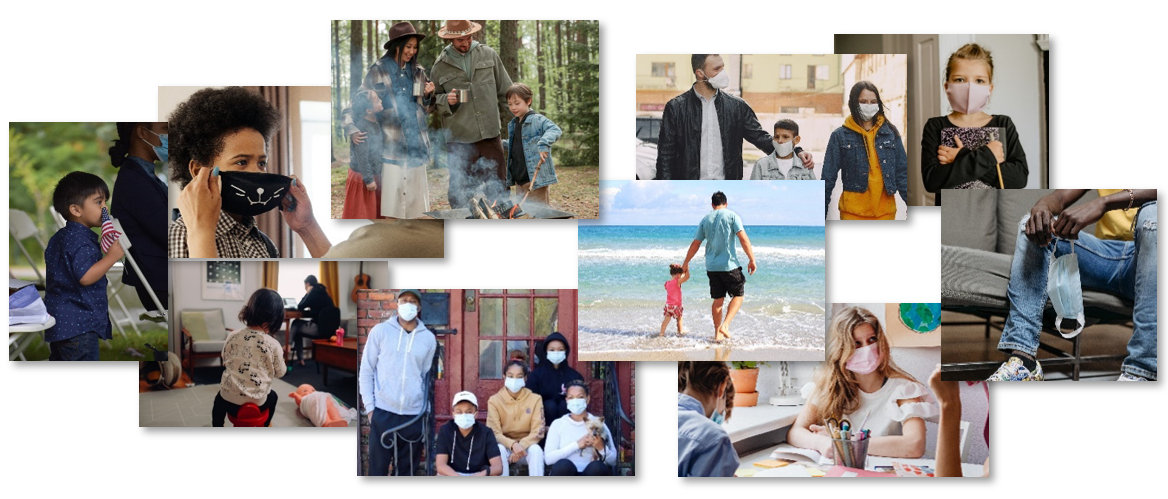At a Crossroads Created by COVID: Families Moving Along the Road to Opportunity in Massachusetts
Executive Summary
Read the full report here.

PART 1: THE PROMISED DESTINATION.
We may have promised the children of Massachusetts that they can arrive at a bright tomorrow full of opportunity, but we have allowed many obstacles to get in the way of that promise for too many of our children. On top of that, these past two years have created new obstacles, and have also put Massachusetts at an important crossroads. The twin health and economic emergencies of the pandemic and subsequent downturn have made long-standing racial and economic inequities worse.

Many of the obstacles on the road to opportunity have been here for generations. After World War II there was widespread prosperity, but employment discrimination, redlining and other discriminatory lending and housing policies created barriers that blocked many people from benefiting from decades of economic growth. In particular, Black veterans were not given access to G.I. benefits, denying them opportunity for homebuying, business creation, and affordable higher education.
The federal government declared a “War on Poverty” in the 1960s to start to address some of the obstacles faced by those the post-war prosperity left behind. As part of the War on Poverty, the federal government created a new definition for “poverty” and started collecting data to track poverty across the nation.
PART 2: UNCOVERING ROADBLOCKS.

The official poverty measure is flawed in how it measures economic well-being, especially in a state like Massachusetts. Although not visible in the “official” poverty rate, spending on food assistance, tax credits, housing assistance, and more have cut poverty in half.
But public benefits alone cannot eliminate poverty, and people need good jobs with good wages that grow over time. Over the past several decades, even though the economy continues to grow, wages and benefits no longer keep up. Low wages mean that many workers need to work more than one job just to stay afloat.
Black and Latinx workers are more likely to have been stuck in lower wage jobs, so these workers are less likely to have incomes sufficient to make ends meet.
Over the past several decades just as wages have stagnated, incomes have also flattened for all but people with the highest incomes.
There are also huge disparities in wealth in Massachusetts, primarily a legacy of the patterns of access to education, jobs, and housing.
PART 3: COMMUNITIES IN TRANSIT.

As the population in Massachusetts grows and changes, old obstacles and new opportunities come into focus. Information about population changes comes from the Census, but early data releases have led to concerns that there might be meaningful undercounts of children and Black and Latinx residents.
Massachusetts continues to be an important destination for people from other nations, but is there a smooth pathway to opportunity for these immigrants?
PART 4: COMMONWEALTH AT THE CROSSROADS.
The long-standing inequities in housing and access to well-paid work played an important role in the spread of COVID. Communities with Black, Latinx, and low-income residents are more likely to be affected by environmental health hazards and poorer access to care, making them more at-risk to the virus. COVID-19 and the economic downturn hit hard, especially for families with fewer available resources to weather hard times.

Inequitable access to affordable and stable housing has been a problem in Massachusetts for generations, but the COVID pandemic has made a bad situation worse.
In early 2020, to help stop the spread of COVID-19, much of the state’s child care system shut down; this meant large swaths of the state’s workforce could not work. School closures and other profound changes in routine and family life and affected the emotional well-being of children and have worsened inequities. The pandemic has worsened a children’s mental health crisis, especially for children with fewer resources to draw on.
PART 5: A ROADMAP FORWARD.
Although progress is delayed, recent policy responses to the pandemic provide glimpses of a roadmap forward to opportunity and equity.
The urgency of need during the pandemic has led to local experiments in getting cash into the hands of families in crisis, including several guaranteed income program pilots.
The federal government has also played a role in helping make sure that families have enough money to make ends meet as a way to address challenges underscored by the pandemic. Financial assistance such as expanded unemployment benefits, expansion and extension of the child tax credit, and additional SNAP benefits all contributed to direct reductions in poverty. The targeted benefits in federal COVID relief legislation have also shown a way towards cutting child poverty in half.

There is also an important role for the state itself to step forward to ensure that current and historic barriers to opportunity are finally dismantled. These solutions can include policy initiatives that:
- Ensure that every family—regardless of immigration status—has enough to make ends meet. Providing an adequate guaranteed income, expanding a state match to the federal earned income tax credit, or establishing a state child tax credit, and supporting aggressive outreach to make sure that every eligible family receives benefits to which they are entitled are proven strategies.
- Help support generational wealth building to disrupt a history of racist policy-making. Whether this is supporting the establishment of community-based small businesses, homeownership programs, or initiatives that cancel student debt or provide a small asset for children that will grow with them into adulthood, there are options that can get a start on addressing wealth inequality.
- Target resources to the communities that have suffered from historic underinvestment. Expanding free public transit, providing universal high quality child care, fully funding our K-12 schools including mental health and other supports for students, making public higher education affordable, or addressing the root causes of unaffordable and unstable housing are all critical next steps to create well-resourced and healthy communities where everyone can thrive.
The revenue the Commonwealth raises to support these investments should not itself perpetuate inequities. Massachusetts’ tax system is “upside down,” currently favoring people who have high incomes over those who do not. Yet taxes are how we raise money so that the state budget can provide what communities need.
Commissioned by:

This research was funded in part by The Annie E. Casey Foundation; Inc., and we thank them for their support; however, findings and conclusions presented in this report are those of the author(s) alone, and do not necessarily reflect the opinions of the Foundation.





